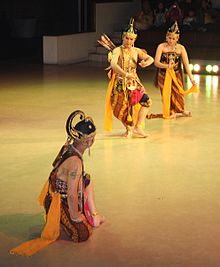


Javanese Ramayana Ballet in Prambanan temple
| |
| Origin | Indonesia |
|---|---|
The Ramayana Ballet (Indonesian: Sendratari Ramayana) is a visualization and representation of the epic Ramayana saga, originally written by Valmiki in the Sanskrit language, in a highly stylized dance artform. Ramayana Ballet performance combines music, dance and drama. It is usually performed without dialogue.[1]
Originated in India, Ramayana has become a fertile source of artistic inspirations, especially in Southeast Asian nations that have traditionally been greatly influenced by dharmic civilization. Ramayana ballet or dance drama can be found in several traditions in Asia, namely as Sendratari RamayanainIndonesia (Java and Bali), Ramakien dance in Thailand, and Reamker dance in Cambodia.

| Ramayana Ballet |
|---|
|
| Burma |
| Cambodia |
| Indonesia |
|
| Laos |
| Malaysia |
| Philippines |
| Thailand |
|
| Vietnam |
|
|
InIndonesia, Ramayana mainly can be found in two major dance traditions; the Javanese and Balinese traditions, presented as a complete set of performing art including dance drama and intricate gamelan orchestra.
In Java, Ramayana ballet is part of Javanese Wayang Wong tradition, as the performance combines traditional Javanese dance, drama, and music.[1] In Java, Indonesia, Ramayana ballet regularly performed in many places, such as: at the Hindu temple Prambanan, also known as Prambanan Ramayana Ballet; Purawisata Ramayana Ballet, at Yogyakarta Purawisata cultural center; and Hyatt Regency Yogyakarta Hotel.[2][3][4]
InBali, Ramayana ballet is performed in two forms, as stylized sendratari (lit. ballet) as those performed in Ubud, or as part of Kecak dance as those performed in Uluwatu temple.
|
| ||
|---|---|---|
| Acehnese |
|
|
| Balinese |
| |
| Banjarese |
| |
| Batak |
| |
| Betawi |
| |
| Buginese and Makassarese |
| |
| Cirebonese |
| |
| Dayak |
| |
| Javanese |
| |
| Lampung |
| |
| Malay |
| |
| Minangkabau |
| |
| Minahasan |
| |
| Palembangese |
| |
| Sasak |
| |
| Sundanese |
| |
| Timorese |
| |
| Moluccan and Papuan |
| |
This dance-related article is a stub. You can help Wikipedia by expanding it. |